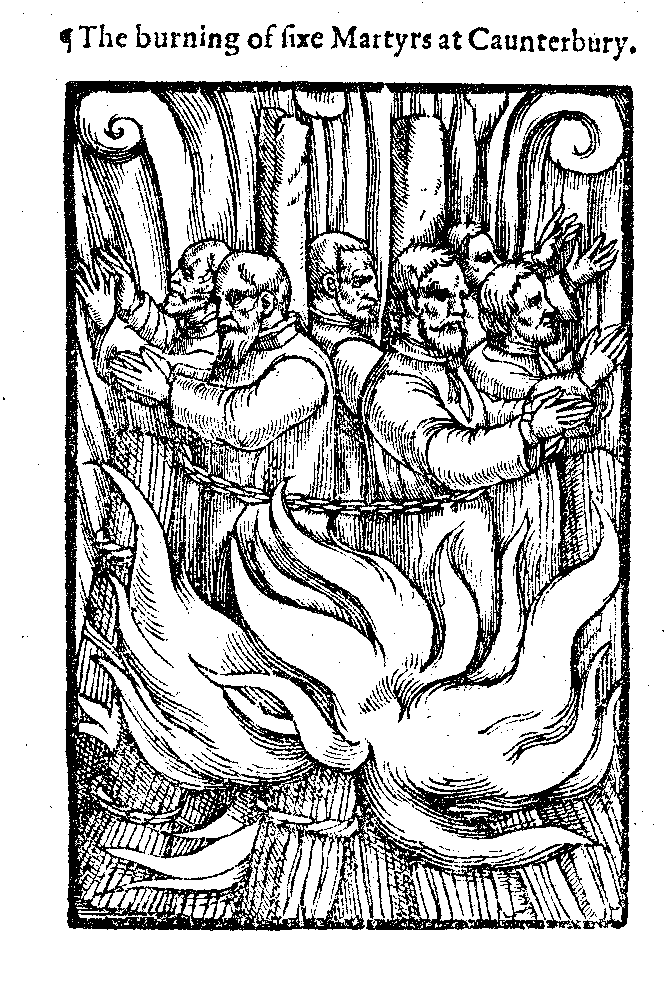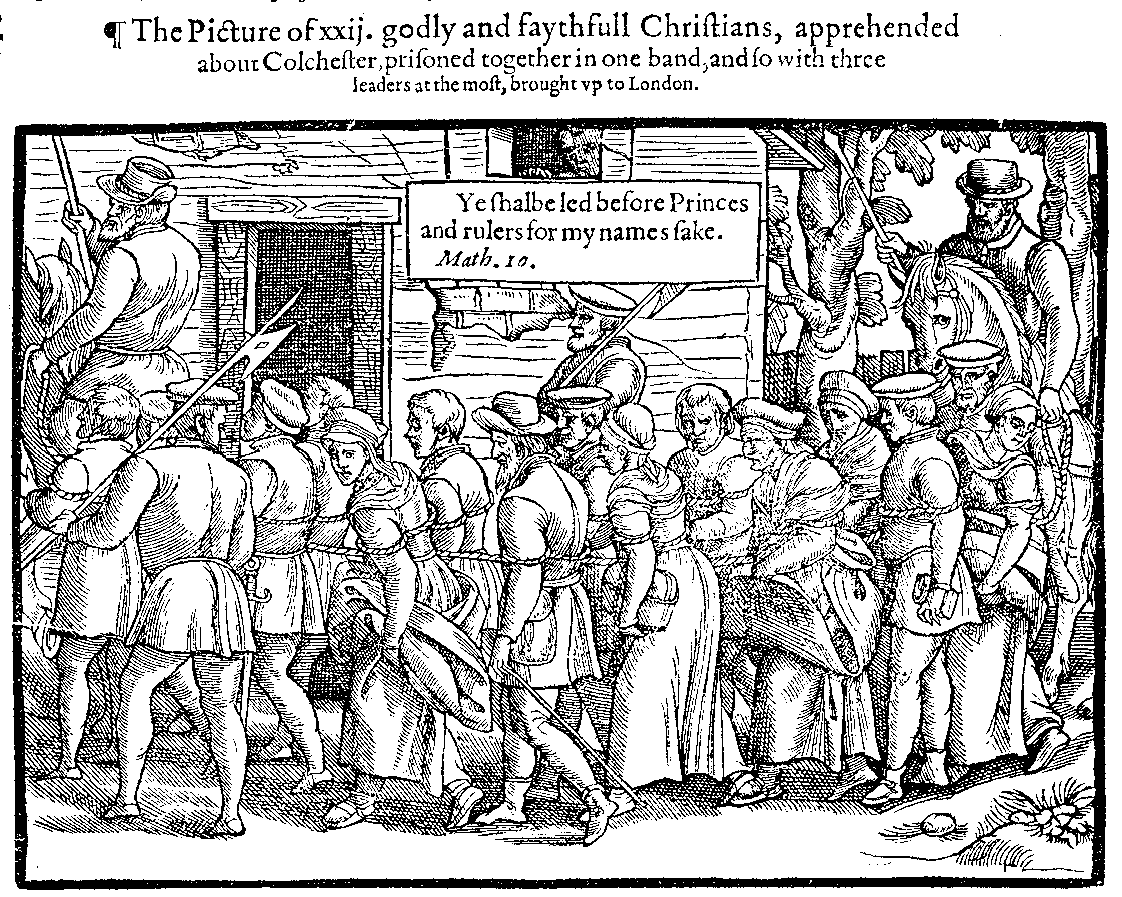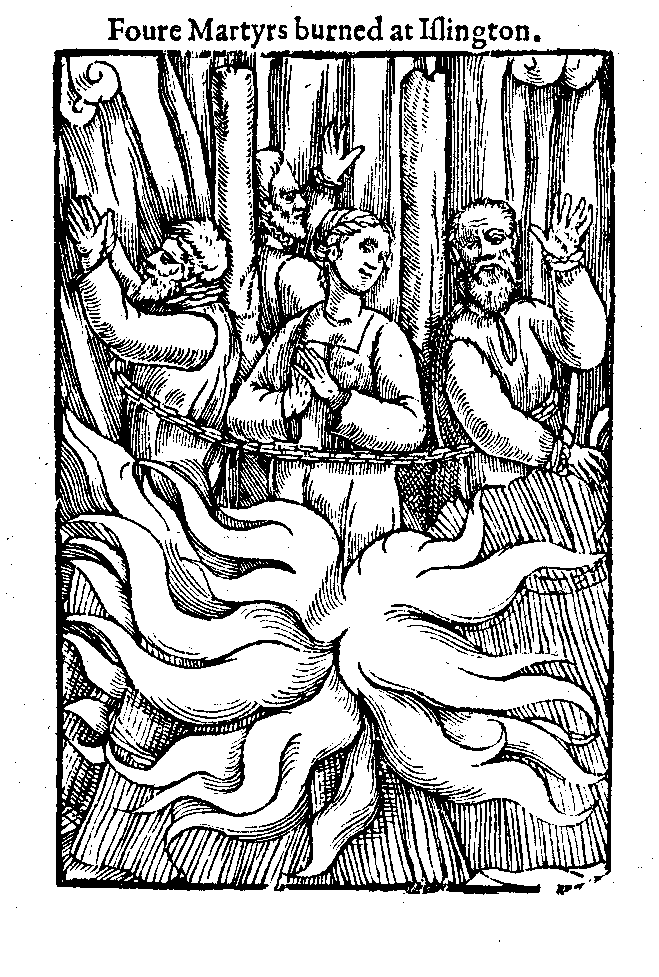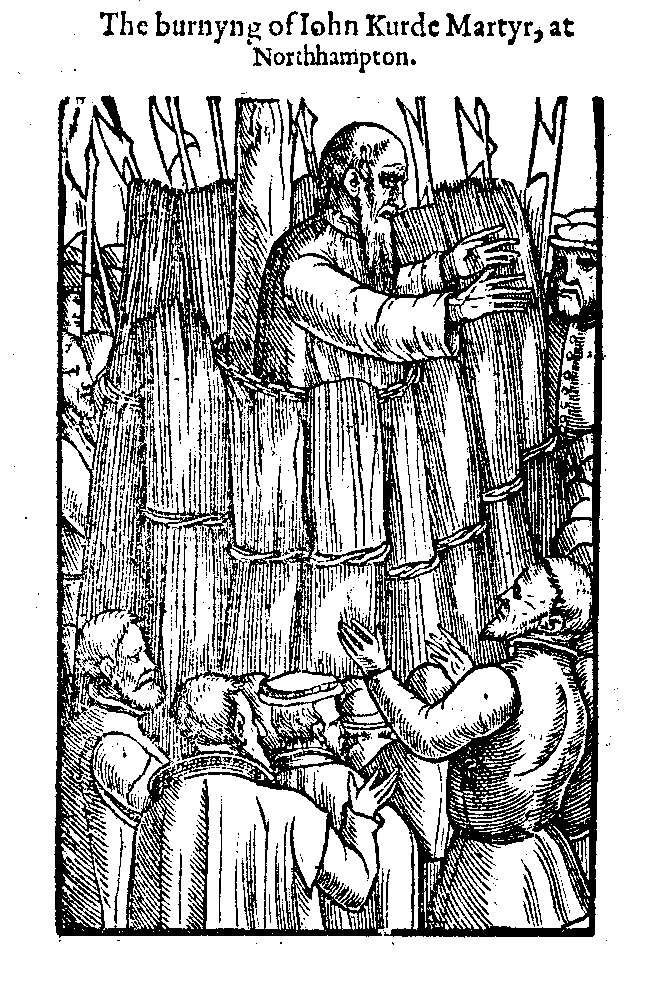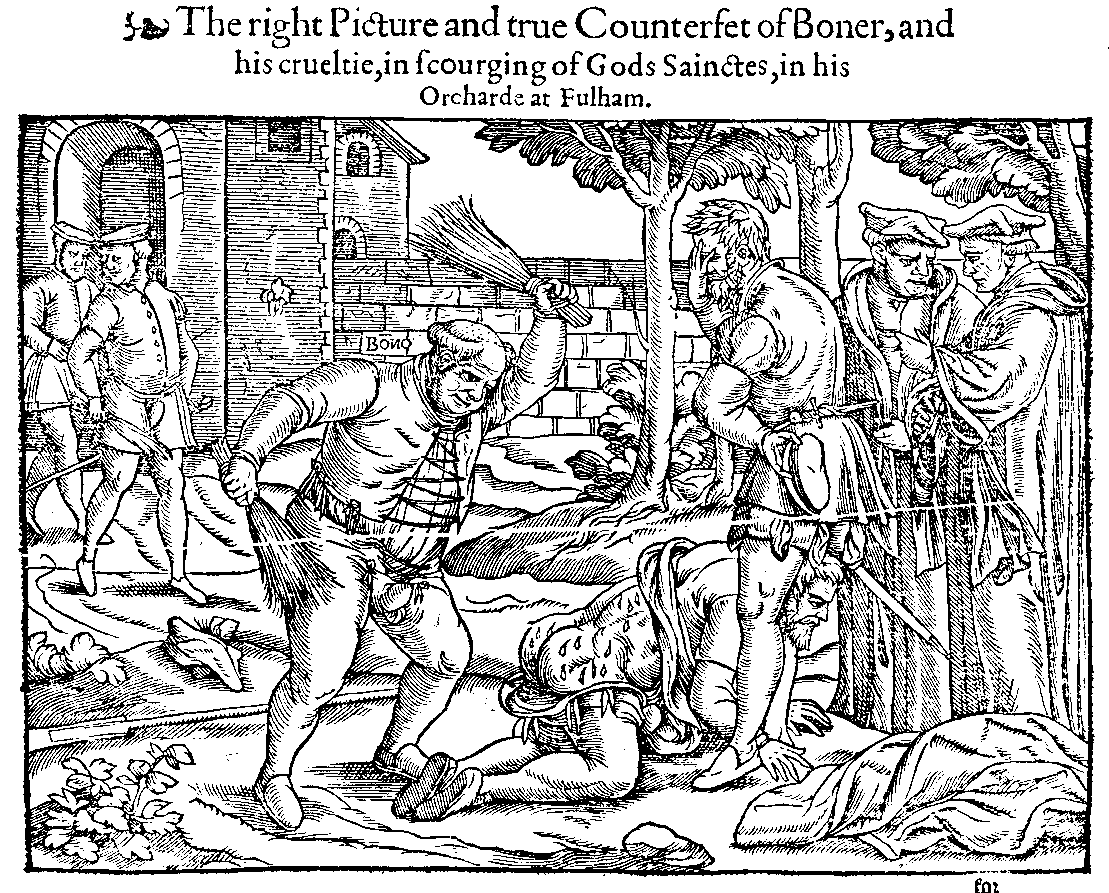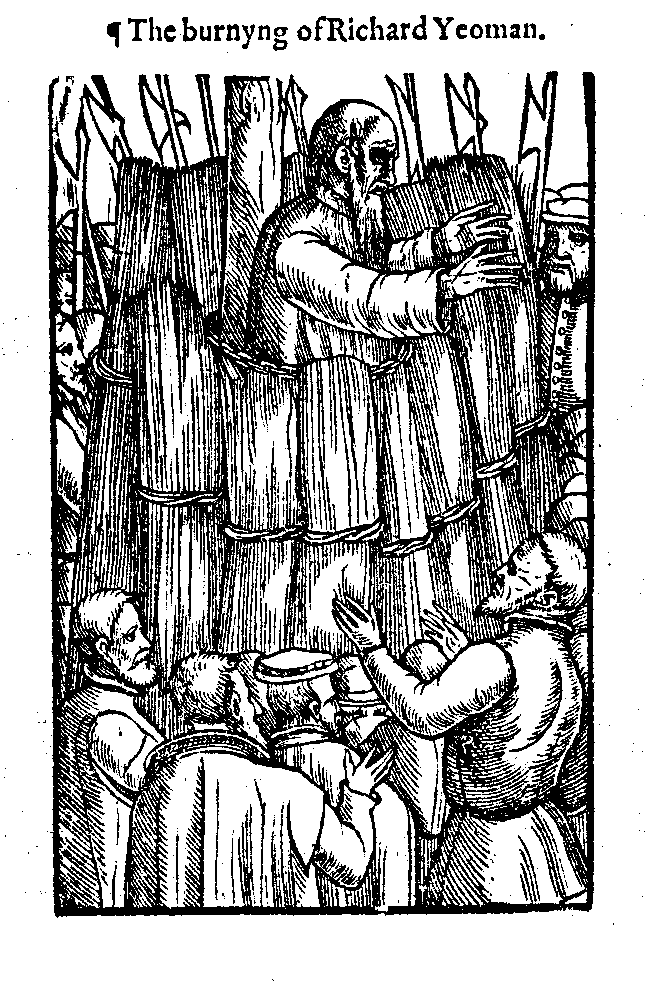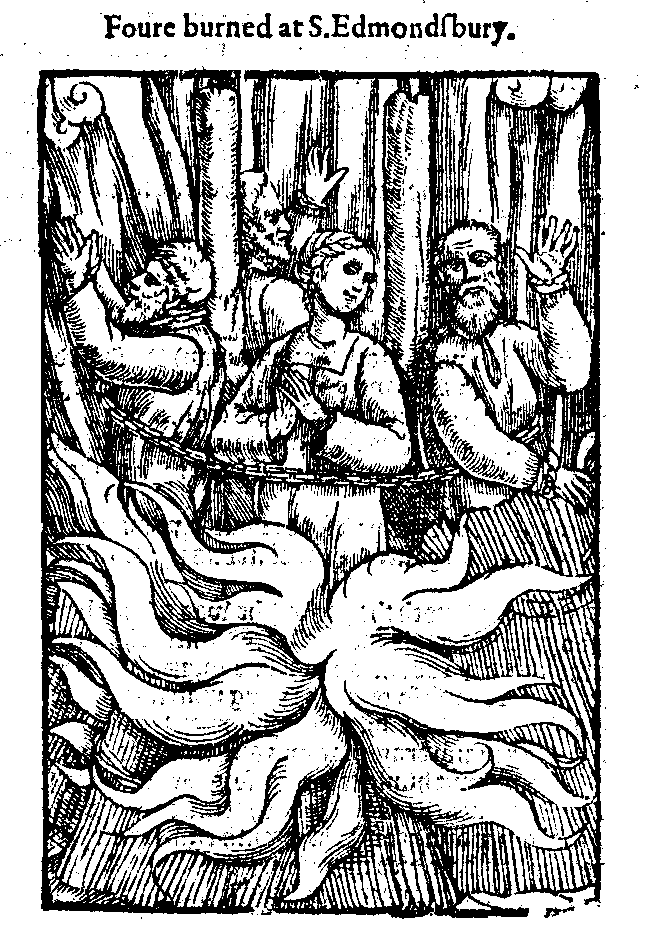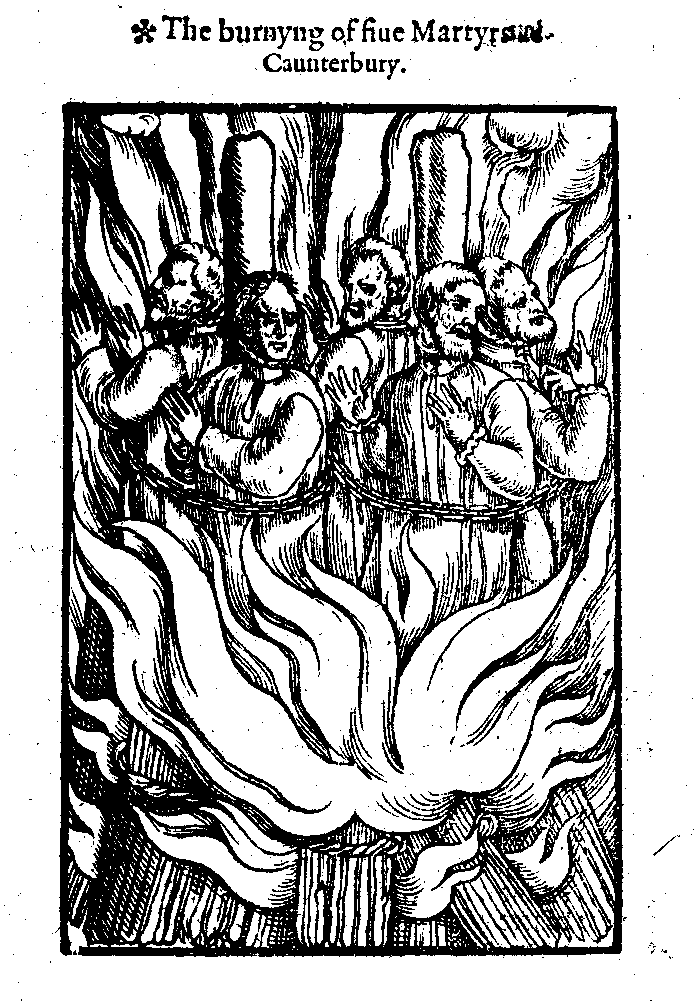Commentary on the TextCommentary on the GlossesCommentary on the WoodcutsLatin/Greek TranslationsCattley Pratt ReferencesThematic DivisionsTextual TranspositionsTextual VariationsGlossary of PeopleGlossary of PlacesEssaysBibliographyAbbreviations
Untitled images of figures in flames, with marginal...The description of the burning of Mayster Bucers and...The burning of sixe Martyrs at CaunterburyThe Picture of xxii. godly and faythfull Christians,...The cruell burning of 5. Martyrs in Smithfield.The burning of seven Martyrs at Caunterburie.The burning of x. Martyrs at Lewes.The Martyrdome of Alexander Gouch, and Driver's wyfeThe burning of Rose Allins handThe martyrdome of three men and three women at Colchester,...Foure Martyrs burned at Islington.The burning of Margaret Thurston, and Agnes Bongeor,...The burnyng of John Kurde, Martyr, at NorthamptonThe burnyng of John Noyes, MartyrThe burnyng of Cicelie Ormes at NorwichA true description of the racking and cruell handeling...Three godly Martirs burned in SmithfieldThe burning of W Nicole at Herefordwest in WalesThree godly Martyrs burned at NorwichThe burning of vii godly martyrs in SmithfieldThe burning of sixe Martyrs at BrainfordeThe right Picture and true Counterfeit of Boner, and...The burnyng of Richard YeomanThe maner of the Popish Spaniardes, in carying Nicholas...The burning of Thomas Benbridge, GentlemanFoure burned at S EdmundsburyThe cruell burning of a woman at ExeterTwo Godly Martyrs burned at BristowThomas Benion burned at BristowThe burning of five Martyrs at Caunterbury
Commentary on the Woodcuts for Book 12
Untitled images of figures in flames, with marginal references to Jone Boughton and Lady Young, Martyr
Foxe is the main source for our knowledge of Joan Boughton, whom he reports to have been over eighty when she was burned at Smithfield, believing Wyclif was a saint. Her daughter, Lady Jane Young, who was thought to have met the same fate at a later date, is more traceable and raises interesting questions about the social networks infected by heresy.
1570 Edition, page 887 | 1576 Edition, page 1943 | 1583 Edition, page 2047[Back to Top]The description of the burning of Mayster Bucers and Paulus Phagius bones and burning of theyr bookes with a solemn procession
Alternative title: 1583: The order and maner of burning M Martin Bucers and Paulus Phagius bones, and also their bookes, with a solemne general procession. At Cambridge. This scene provided an opportunity to display, through the 'general procession', the rejected pomp of papal ritual, as depicted in small in the title-page. Here too we see tonsured priests processing with service-books, the holy sacrament under its canopy adorned with crosses, banners of the Trinity and (at the head) St George, the blazing torches, bell-ringing and candles all presented as comparable to a rite of pagan Rome. At the centre the burning of whole panniers of large volumes (leaves floating away in the air) emphasise the literary heritage of the two men whose boxed bones are chained to the stake. The arc of people surrounding the pyre is comparable to the woodcut of 'The solemne procession of the triumphant Church of Rome, used at the execution of poore Christians', illustrating an auto-da-fé of the Spanish inquisition in John Day's 1569 edition of Reginaldus Gonsalvius Montanus, A discovery and playne declaration of sundry subtill practises of the holy inquisition of Spayne (STC 11997). In 1569 Day also printed a Dutch edition, which was intended to carry the illustration. The English version was translated by V. Skinner with a dedication to Archbishop Parker, and the rarity of surviving copies of the large fold-out woodcut (270 x 360) is doubtless explicable by its removal for wall posting. The tipping in of Foxe's woodcut allowed such use for the Bucer-Fagius illustration, except in the 1570 edition. A relationship between the Gonsalvius woodcut and the earlier Bucer-Fagius one is made more likely by the passage of a woodcut from Day's Dutch edition into 1570, p. 1724, and by the fact that the same cutter was responsible for both the 'Solemn Procession ' and the 'Ten Persecutions' woodcut in 1570. There is also a distinct family resemblance between the two figures in the fire at the centre of the 'Solemn Procession' and Acts and Monuments burnings (e.g. small cut (f) of Type 2 with bearded martyrs wearing loin cloths). The links between these images is suggestive of Day's active participation in the illustrative programme.
1563 Edition, page 1629 | 1570 Edition, page 2191 | 1576 Edition, page 1885[Back to Top]The burning of sixe Martyrs at Caunterbury
A repeat of a block used on various occasions. See 1570, p. 1868.
1570 Edition, page 2194 | 1576 Edition, page 1888 | 1583 Edition, page 1994[Back to Top]The Picture of xxii. godly and faythfull Christians, apprehended about Colchester, prisoned together in one band, and so with three leaders at the most, brought up to London.
The scene of 22 prisoners being driven, so like so many sheep or cattle, to walk the 60 miles from Colchester to London, was one of the martyrologist's plentiful illustrations of Bishop Bonner's cruelty. In this case it is given a quite specific biblical context. Chapter 10 of Matthew, verse 18 of which is inscribed in the print, speaks of persecution in just such terms; verse 16 warns 'Behold I send you as sheep in the midst of wolves' (which in the Geneva version is annotated 'You shall be in great danger'). The fifteen prisoners, old and young, seen here roped together and hemmed in by two mounted guards and two pikemen, trudge obediently between their warders, bearing their few possessions, in one case what looks like a book. Above, a sinister face looks out from the dark opening of the window. And one young woman, turning sideways, seems to look directly at the viewer.
1563 Edition, page 1647 | 1570 Edition, page 2198 | 1576 Edition, page 1891 | 1583 Edition, page 1997[Back to Top]The cruell burning of 5. Martyrs in Smithfield.
Having been used for the five martyrs of Canterbury (which it fitted) the block was here reused inappropriately for the martyrdom of three men and two women, whose names are given in the margin.
1570 Edition, page 2201 | 1576 Edition, page 1894 | 1583 Edition, page 2000[Back to Top]The burning of seven Martyrs at Caunterburie.
An example of a small cut (Type 1) which was a self-evident misfit, given the marginal note 'The Martyrdome of 3. men, and 4. women'. It was, however, accurate for the Colchester burning two months later, for which it was reused (1583, p. 2008).
1570 Edition, page 2208 | 1576 Edition, page 1900 | 1583 Edition, page 2005[Back to Top]The burning of x. Martyrs at Lewes.
This was the largest number of martyrs attempted in a small cut (this of Type 1) and the designer has not tried to convey so many individuals in the crowded space, though there is a suggestion of perhaps more than three stakes.
1570 Edition, page 2235 | 1576 Edition, page 1922 | 1583 Edition, page 2027[Back to Top]The Martyrdome of Alexander Gouch, and Driver's wyfe
The reuse of this woodblock (by a designer with a distinctive style of flaring flames wrapped round the bodies of martyrs, to whom 'The Burning of William Sawter' in 1401 and Bishop Farrar (1563, pp. 142, 1100) can also be attributed, reflects the readiness of the printer to continue to utilise existing woodblocks, however unsatisfactory for his improved design and layout. In fact this block, measuring 140 x 98 mm in its original state, was unsatisfactory from the start, necessitating a peculiar layout in 1563 with an odd-shaped column of text alongside to accommodate the print. Things were not much improved in 1570 and 1583, when the block was truncated on both sides, since it still overran the column of text. This strongly suggests that this, and the Sawtry and Farrar blocks, were all imports of some kind, which were not specifically made for the Acts and Monuments. In 1563 and 1570 this block was used to illustrate the burning of Simon Myller and Elizabeth Cooper, whose names were inscribed in the banderole over their heads. In 1583 the Myller-Cooper block, now with the names excised, leaving a blank scroll overhead, was used for the martyrdom of Alexander Gouch and Driver's wife. Myller and Cooper were left unpictured.
1583 Edition, page 2073[Back to Top]The burning of Rose Allins hand
As the Marian persecution reaches its peak, Bishop Bonner, Foxe's arch-villain, receives an increasing coverage of pictorial denigration and caricature. Readers learned how to recognize his features, as well as his grotesque activities. This event is a close parallel to the earlier burning of Tomkins' hand, carried out by Bonner himself. The actor here is Thomas Tyrrell, presented as a man of murderous bloodline. He holds the sufferer's hand in the candle flame - just as Bonner had held Tomkins' - till the household could hear the sinews crack. The girl triumphantly endures, though she might have attacked her torturer with the pitcher of water her bedridden mother is waiting for. The inset scene of three martyrs praying in flames makes visually explicit the obvious links between two sorts of trial by fire, and Foxe's text returns to his earlier parallel in Livy of King Porsena and the burning of M. Scaevola's hand, and gives yet another example of Bonner's hand burning.
1563 Edition, page 1787 | 1570 Edition, page 2239 | 1576 Edition, page 1925 | 1583 Edition, page 2030[Back to Top]The martyrdome of three men and three women at Colchester, burned in the forenone, besides 4 other burned at the after noone
A repeat of the woodcut used for seven martyrs of Canterbury.
1570 Edition, page 2242 | 1576 Edition, page 1927 | 1583 Edition, page 2032[Back to Top]Foure Martyrs burned at Islington.
This woodcut (Type 1), with its correct representation of three men and one woman praying and signalling with raised hands, was for martyrs who ended their lives 'most joyfully'. Its single subsequent reuse was inappropriately for four men burned two years later at 'S. Edmunds Bury' (Bury St Edmunds).
1570 Edition, page 2255 | 1576 Edition, page 1939 | 1583 Edition, page 2043[Back to Top]The burning of Margaret Thurston, and Agnes Bongeor, at Colchester.
A repeat of the cut used for two women burned at Ipswich the previous year.
1570 Edition, page 2256 | 1576 Edition, page 1940 | 1583 Edition, page 2044[Back to Top]The burnyng of John Kurde, Martyr, at Northampton
The fourth appearance of this cut in Books 11 and 12 in 1583.
1570 Edition, page 2257 | 1576 Edition, page 1940 | 1583 Edition, page 2045[Back to Top]The burnyng of John Noyes, Martyr
First repeat of the woodcut that had appeared many pages earlier, serving Thomas Tomkyns.
1570 Edition, page 2258 | 1576 Edition, page 1941 | 1583 Edition, page 2046[Back to Top]The burnyng of Cicelie Ormes at Norwich
There already existed a small block (Type 1) of a single woman at the stake, but a new image (Type 2) portrayed the 'very simple woman', Cicelie Ormes at the stake she had welcomed as the cross of Christ. This woodcut remained unique to her and did not serve any other woman martyr - a fact that says something about Foxe's estimate of these martyrs. It disappeared from the Book of Martyrs after Foxe's death, having been used to illustrate a murder pamphlet.
1570 Edition, page 887 | 1576 Edition, page 1943 | 1583 Edition, page 2047[Back to Top]A true description of the racking and cruell handeling of Cuthbert Simpson in the Tower
The very explicit detail of Cuthbert Simpson's 'cruel handling' in the Tower, shows conventional torture being used to test the accused. The woodcut, with its inset captions, is anxious to emphasise the veracity of what is presented. In the foreground two men are straining the ropes of the instrument which could dislocate joints, the rack, which had been used in the Tower over a century earlier (and which enjoyed various nicknames). The labelled insets of other kinds of torture make this illustration comparable to the huge woodcut the Ten Persecutions of the Primitive Church, whose varied annotated sufferings of early church martyrs were seen by Foxe as patterns for the martyrs of his own day. Foxe's text, putting praise for Simpson's endurance of his racking into the mouth of Bonner himself, indicates that the bishop had witnessed this 'patience' in person, through the 'sorrow' inflicted in his episcopal residence.
1563 Edition, page 1732 | 1570 Edition, page 2269 | 1576 Edition, page 1952 | 1583 Edition, page 2056[Back to Top]Three godly Martirs burned in Smithfield
As the amount of illustration thickens through the concluding pages of the Book of Martyrs, new small cuts were still appearing alongside the repeating images. This example (Type 1) appears next a recycled print of the same family of cuts, though it seems rather a peculiar new arrival at this stage, since there were already two small blocks showing two men in the flames, and what was needed here was one showing three (which the producers did not have). Does this suggest some kind of bulk commissioning, as well as the cutting of designs specifically tailored to the text?
1570 Edition, page 2271 | 1576 Edition, page 1954 | 1583 Edition, page 2058[Back to Top]The burning of W Nicole at Herefordwest in Wales
Another repeat of the cut that had illustrated Thomas Tomkyns.
1570 Edition, page 2272 | 1576 Edition, page 1954 | 1583 Edition, page 2058[Back to Top]Three godly Martyrs burned at Norwich
Another example of the lack of a block to illustrate three men in one pyre.
1570 Edition, page 2273 | 1576 Edition, page 1955 | 1583 Edition, page 2060[Back to Top]The burning of vii godly martyrs in Smithfield
Another example of the quest for full illustration overriding full provision (Day had no cut for seven in one pyre).
1570 Edition, page 2277 | 1576 Edition, page 1959 | 1583 Edition, page 2063[Back to Top]The burning of sixe Martyrs at Brainforde
The fifth use of this cut in the last two books in 1583.
1570 Edition, page 2281 | 1576 Edition, page 1963 | 1583 Edition, page 2066[Back to Top]The right Picture and true Counterfeit of Boner, and his crueltie, in scourging of Gods Sainctes, in his Orchard at Fulham
Bishop Bonner (who perhaps scarcely needed the label attached to his garden wall in this woodcut) is particularly vivid in his characterisation here as the fat unlaced figure of ridicule acting as master of devilish ceremony. There was no mistaking his outrageousness, as he beat the prisoner John Willes so hard that he wore out his willow scourge and turned to a birch one, drawing so much blood that even his attendants recoiled. This was a device used elsewhere by the illustrators, and here all eyes are averted from Bonner's actions - the two clerks confer on their own, the servants coming in with a fresh birch whip turn away, and the man whose job it is to hold down the unfortunate prisoner covers his eyes. Bonner, who died in 1569, was still alive when the first edition of the Acts and Monuments appeared, and according to John Harington's later story, when shown his picture in the work laughed and said, 'a vengeance on the foole, how could he get my picture drawn so right?' In conflating the accounts of this episode in the text the illustrators took some liberties, for instance with the 'lad' bringing the new birch rod, and the victim, Thomas Hinshaw - reported as aged 19 or 20 - both of whom appear older. They were ready to rise above the specifics of textual fidelity in order to produce an image of Bonner's personal cruelty on a par with the corporate cruelties of the persecuting 'true Catholic Church of Christ' (represented in the first woodcut of 'The Proud Primacy of Popes' series, 1570, sig. nnir; 1576, p. 756; 1583, 780. Play on Bonner's name added to the visual exploitation of his character. What good qualities could be found in this bishop who combined the role of ruthless persecutor with the rauncy as well as the pauncy Vice of old comedy fame? The point was made in a simple pun. 'Boner' for Bonner ('Bono' inscribed on the wall behind him - very much the contrary of its Latin meaning (bonus, good).
1563 Edition, page 1770 | 1570 Edition, page 2282 | 1576 Edition, page 1963 | 1583 Edition, page 2067[Back to Top]The burnyng of Richard Yeoman
This was the fifth time this image was used in Books 11 and 12 in 1583.
1570 Edition, page 2285 | 1576 Edition, page 1966 | 1583 Edition, page 2069[Back to Top]The maner of the Popish Spaniardes, in carying Nicholas Burton a blessed Martyr of Christ, after most spitefull sort, to the burning
The case of the English merchant Nicholas Burton, arrested and condemned by the inquisition in Spain, gave Foxe and his illustrators an opportunity to portray the evils of the papal inquisition. The bipartite woodcut shows the condemned riding ignominiously backwards on a donkey or mule, in a heretic's coat and hat adorned with devils, of the kind that medieval heretics such as Jan Hus (portrayed earlier in the Acts and Monuments) had had to wear. Also conspicuous is the inevitable malign friar, scrip at side, becowled, ugly visaged and holding forth, accompanied by a large posse of armed men (one with a ball and chain). In the distance is depicted the culmination of the proceedings, after the vast procession has reached the place of execution, where the martyr is collapsing into the fire, repeating in small the image so familiar in the pages of Foxe's book.
1563 Edition, page 1814 | 1570 Edition, page 2298 | 1576 Edition, page 1977 | 1583 Edition, page 2081[Back to Top]The burning of Thomas Benbridge, Gentleman
A cut which already had a chipped top edge in 1570, at its earlier use to illustrate the martyrdom of William Halle.
1570 Edition, page 2286 | 1576 Edition, page 1967 | 1583 Edition, page 2071[Back to Top]Foure burned at S Edmundsbury
Having earlier served the four martyrs of Islington, one of whom was a woman, the image is here drafted in to illustrate four men.
1583 Edition, page 2071[Back to Top]The cruell burning of a woman at Exeter
The poor woman, finally identified as 'one Prestes wyfe' was sufficiently important to warrant a new, third, small woodcut of a woman at the stake. She has been given strong individual features.
1570 Edition, page 2292 | 1576 Edition, page 1972 | 1583 Edition, page 2076[Back to Top]Two Godly Martyrs burned at Bristow
1570 Edition, page 2292 | 1576 Edition, page 1972 | 1583 Edition, page 2076[Back to Top]Thomas Benion burned at Bristow
1570 Edition, page 2293 | 1576 Edition, page 1973 | 1583 Edition, page 2077[Back to Top]The burning of five Martyrs at Caunterbury
Another instance in which the picture did not fit the sexes of the group of martyrs.
1570 Edition, page 2293 | 1576 Edition, page 1973 | 1583 Edition, page 2077[Back to Top]


